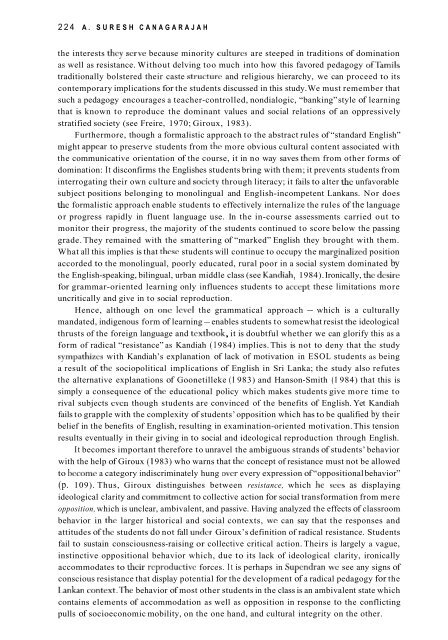English Language Teaching in its Social Context
English Language Teaching in its Social Context
English Language Teaching in its Social Context
You also want an ePaper? Increase the reach of your titles
YUMPU automatically turns print PDFs into web optimized ePapers that Google loves.
224 A. SURESH CANAGARAJAHthe <strong>in</strong>terests they serve because m<strong>in</strong>ority culturcs are steeped <strong>in</strong> traditions of dom<strong>in</strong>ationas well as resistance. Without delv<strong>in</strong>g too much <strong>in</strong>to how this favored pedagogy ofTamilstraditionally bolstered their caste structure and religious hierarchy, we can proceed to <strong>its</strong>contemporary implications for the students discussed <strong>in</strong> this study. We must remember thatsuch a pedagogy encourages a teacher-controlled, nondialogic, “bank<strong>in</strong>g” style of learn<strong>in</strong>gthat is known to reproduce the dom<strong>in</strong>ant values and social relations of an oppressivelystratified society (see Freire, 1970; Giroux, 1983).Furthermore, though a formalistic approach to the abstract rules of “standard <strong>English</strong>”might appear to preserve students from the more obvious cultural content associated withthe communicative orientation of the course, it <strong>in</strong> no way saves them from other forms ofdom<strong>in</strong>ation: It disconfirms the <strong>English</strong>es students br<strong>in</strong>g with them; it prevents students from<strong>in</strong>terrogat<strong>in</strong>g their own culture and socicty through literacy; it fails to alter the unfavorablesubject positions belong<strong>in</strong>g to monol<strong>in</strong>gual and <strong>English</strong>-<strong>in</strong>competent Lankans. Nor doesthe formalistic approach enable students to effectively <strong>in</strong>ternalize the rules of the languageor progress rapidly <strong>in</strong> fluent language use. In the <strong>in</strong>-course assessments carried out tomonitor their progress, the majority of the students cont<strong>in</strong>ued to score below the pass<strong>in</strong>ggrade. They rema<strong>in</strong>ed with the smatter<strong>in</strong>g of “marked” <strong>English</strong> they brought with them.What all this implies is that these students will cont<strong>in</strong>ue to occupy the marg<strong>in</strong>alizcd positionaccorded to the monol<strong>in</strong>gual, poorly educated, rural poor <strong>in</strong> a social system dom<strong>in</strong>ated bythe <strong>English</strong>-speak<strong>in</strong>g, bil<strong>in</strong>gual, urban middle class (see Kantliah, 1984). Ironically, the desirefor grammar-oriented learn<strong>in</strong>g only <strong>in</strong>fluences students to accept these limitations moreuncritically and give <strong>in</strong> to social reproduction.Hence, although on one level the grammatical approach ~ which is a culturallymandated, <strong>in</strong>digenous form of learn<strong>in</strong>g ~ enables students to somewhat resist the ideologicalthrusts of the foreign language and textbook, it is doubtful whether we can glorify this as aform of radical “resistance” as Kandiah (1984) implies. This is not to deny that the studysympathizes with Kandiah’s explanation of lack of motivation <strong>in</strong> ESOL students as be<strong>in</strong>ga result of the sociopolitical implications of <strong>English</strong> <strong>in</strong> Sri Lanka; the study also refutesthe alternative explanations of Goonetilleke (1983) and Hanson-Smith (1984) that this issimply a consequence of the educational policy which makes students give more time torival subjects even though students are conv<strong>in</strong>ced of the benef<strong>its</strong> of <strong>English</strong>. Yet Kandiahfails to grapple with the complexity of students’ opposition which has to be qualified by theirbelief <strong>in</strong> the benef<strong>its</strong> of <strong>English</strong>, result<strong>in</strong>g <strong>in</strong> exam<strong>in</strong>ation-oriented motivation. This tensionresults eventually <strong>in</strong> their giv<strong>in</strong>g <strong>in</strong> to social and ideological reproduction through <strong>English</strong>.It becomes important therefore to unravel the ambiguous strands of students’ behaviorwith the help of Giroux (I 983) who warns that the concept of resistance must not be allowedto become a category <strong>in</strong>discrim<strong>in</strong>ately hung over every expression of “oppositional behavior”(p. 109). Thus, Giroux dist<strong>in</strong>guishes between resistance, which he sees as display<strong>in</strong>gideological clarity and commitmcnt to collective action for social transformation from mereopposition, which is unclear, ambivalent, and passive. Hav<strong>in</strong>g analyzed the effects of classroombehavior <strong>in</strong> the larger historical and social contexts, we can say that the responses andattitudes of the students do not fall untlcr Giroux’s def<strong>in</strong>ition of radical resistance. Studentsfail to susta<strong>in</strong> consciousness-rais<strong>in</strong>g or collective critical action. Theirs is largely a vague,<strong>in</strong>st<strong>in</strong>ctive oppositional behavior which, due to <strong>its</strong> lack of ideological clarity, ironicallyaccommodates to their reproductive forces. It is perhaps <strong>in</strong> Supendran we see any signs ofconscious resistance that display potential for the development of a radical pedagogy for theLankan context.The behavior of most other students <strong>in</strong> the class is an ambivalent state whichconta<strong>in</strong>s elements of accommodation as well as opposition <strong>in</strong> response to the conflict<strong>in</strong>gpulls of socioeconomic mobility, on the one hand, and cultural <strong>in</strong>tegrity on the other.












